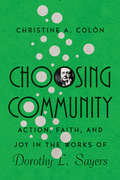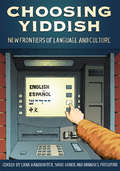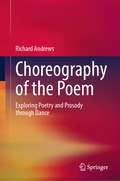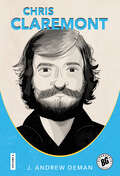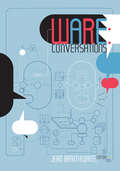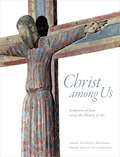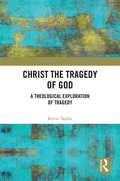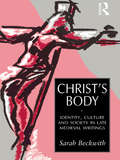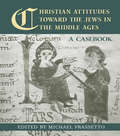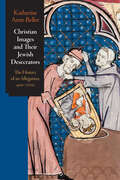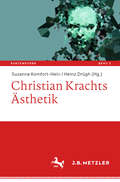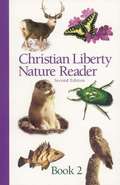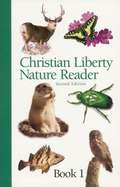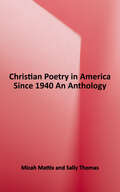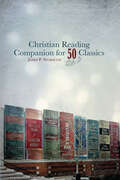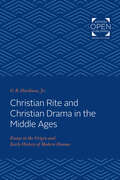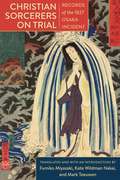- Table View
- List View
Choosing Community: Action, Faith, and Joy in the Works of Dorothy L. Sayers (Hansen Lectureship Series)
by Christine A. ColònFew writers in the twentieth century were as creative and productive as Dorothy L. Sayers, the English playwright, novelist, and poetDivine ComedyAmong the prominent themes of her work was the need for and challenges of developing community. Sayers, who was herself an active member of various writing groups throughout her lifetime, offers her readers visions of both fractured and harmonious communities.In this Hansen Lectureship volume, Christine Colón explores the role of community in Sayers's works. In particular, she considers how Sayers offers a vision of communities called to action, faith, and joy, and she reflects on how we also are called to live in community together.Based on the annual lecture series hosted at Wheaton College's Marion E. Wade Center, volumes in the Hansen Lectureship Series reflect on the imaginative work and lasting influence of seven British authors: Owen Barfield, G. K. Chesterton, C. S. Lewis, George MacDonald, Dorothy L. Sayers, J. R. R. Tolkien, and Charles Williams.
Choosing The Right Pet for Ben class 1 - MIE
by Dr Pascal Nadal"Choosing The Right Pet for Ben" is a charming children's book centered around Ben's desire for a birthday pet. Faced with Ben's imaginative choices like a protective gorilla or a fast horse, his parents gently guide him toward more feasible options like a cat, dog, or fish. Through a delightful dialogue, the book navigates Ben's initial outlandish requests, offering a glimpse into his innocent aspirations and parental guidance. It cleverly discusses various animals, their habitats, and appropriateness as pets, culminating in Ben's decision to adopt a hamster, fostering a heartwarming resolution. The book not only captivates young readers with its engaging narrative but also imparts subtle lessons about responsible pet ownership, animal habitats, and the importance of making practical choices. With its colorful illustrations, simple language, and relatable characters, this story is tailored to resonate with Grade 1 pupils, serving as a valuable educational tool in developing literacy skills and sparking curiosity about pets and their environments.
Choosing Yiddish: New Frontiers of Language and Culture
by Dara Horn Jeffrey Shandler Jeremy Dauber Josh Lambert Barbara Kirshenblatt-Gimblett Kalman Weiser Hasia Diner Ari Y. Kelman Tony Michels Gennady Estraikh Sarah Bunin Benor Anita Norich Rebecca Margolis Zehavit Stern Asya Vaisman Shiri Goren Lara Rabinovitch Gerben Zaagsma Edward Portnoy Jennifer Young Ela Bauer Shachar Pinsker Shayn Smulyan Adriana X. Jacobs Barbara Mann Jordan Finkin Rebecca Kobrin Hannah S. Pressman Anna ShternshisYiddish Hip Hop, a nineteenth-century "Hasidic Slasher," obscure Yiddish writers, and immigrant Jewish newspapers in Buenos Aires, Paris, and New York are just a few of the topics featured in Choosing Yiddish: New Frontiers of Language and Culture. Editors Lara Rabinovitch, Shiri Goren, and Hannah S. Pressman have gathered a diverse and richly layered collection of essays that demonstrates the currency of Yiddish scholarship in academia today.Organized into six thematic rubrics, Choosing Yiddish demonstrates that Yiddish, always a border-crossing language, continues to push boundaries with vigorous disciplinary exchange. "Writing on the Edge" focuses on the realm of belles lettres; "Yiddish and the City" spans the urban centers of Paris, Buenos Aires, New York City, and Montreal; "Yiddish Goes Pop" explores the mediating role of Yiddish between artistic vision and popular culture; "Yiddish Comes to America" focuses on the history and growth of Yiddish in the United States; "Yiddish Encounters Hebrew" showcases interactions between Yiddish and Hebrew in the late nineteenth and twentieth centuries; and "Hear and Now" explores the aural dimension of Yiddish in contemporary settings. Along the way, contributors consider famed and lesser-known Yiddish writers, films, and Yiddish hip-hop, as well as historical studies on the Yiddish press, Yiddish film melodrama, Hasidic folkways, and Yiddish culture in Israel. Venerable scholars introduce each rubric, creating additional dialogue between newer and more established voices in the field.The international contributors prove that the language--far from dying--is fostering exciting new directions of academic and popular discourse, rooted in the field's historic focus on interdisciplinary research. Students and teachers of Yiddish studies will enjoy this innovative collection.
Choral Mediations in Greek Tragedy
by Marianne Govers Hopman Renaud GagnéThis volume explores how the choruses of Ancient Greek tragedy creatively combined media and discourses to generate their own specific forms of meaning. The contributors analyse choruses as fictional, religious and civic performers; as combinations of text, song and dance; and as objects of reflection in themselves, in relation and contrast to the choruses of comedy and melic poetry. Drawing on earlier analyses of the social context of Greek drama, the non-textual dimensions of tragedy, and the relations between dramatic and melic choruses, the chapters explore the uses of various analytic tools in allowing us better to capture the specificity of the tragic chorus. Special attention is given to the physicality of choral dancing, musical interactions between choruses and actors, the trajectories of reception, and the treatment of time and space in the odes.
Choreographing Shakespeare: Dance Adaptations of the Plays and Poems
by Elizabeth KlettChoreographing Shakespeare presents a hitherto unexplored history of the choreographers and performers who have created dance adaptations of Shakespeare. This book investigates forty dance works in genres such as ballet, modern dance, and hip-hop, produced between 1940 and 2016 by choreographers in Britain, America, and Europe, all of which use Shakespeare’s plays and Sonnets as their source material. By combining scholarly analysis of these productions with practice-based conversations from six contemporary choreographers, Klett offers both breadth of coverage and in-depth analysis of how Shakespeare’s poetic language is translated into the usually wordless medium of dance, and shows exactly how these dance adaptations move beyond the Shakespearean texts to engage with musical and choreographic influences. Ideal for students of Shakespeare and Dance Studies, Choreographing Shakespeare explores how dance adaptations strive to design legible and intelligible stories, while ultimately celebrating the beauty of pure movement.
Choreography of the Poem: Exploring Poetry and Prosody through Dance
by Richard AndrewsThis book explores analogies and correspondences between dance and poetry, with an emphasis on how dance and dance choreography can shed light on poetry, poetic form and the teaching of poetry. Chronologically, the book examines the Renaissance/Baroque period in Europe and moves through early modern to contemporary poetry and dance. Internationally, it explores Asian, African and American dance choreographies and poetry alongside European, as well as hybrid influences of the different traditions on each other. It argues that the poem on the page, and in spoken performance, inhabits space within frameworks of expectation. Choreography of the Poem accesses interest from the perspectives of each of the modes of communication: physical movement in dance, and spoken and written communication in poetry. It reveals what dance choreography can bring to an understanding and appreciation of the making of poetry in schools, colleges and universities.
Chris Argyris's Integrating The Individual and the Organization (The Macat Library)
by Stoyan StoyanovArgyris’s Integrating The Individual and the Organization is part of a series of essays and books considering how organisations should be run. This essay explores the lack of congruence between the needs and expectations of individual employees and the organisations that employ them. Grounding his argument in studies on human nature, Argyris highlights that demands of greater independence, an expansion of interests, and re-orientation of goals usually accompany maturation, which is at odds with higher control stemming from formal organisations. This frustration, he contends, is detrimental to productivity, increases the chance of failure and causes conflict.
Chris Claremont (Biographix)
by J. Andrew DemanChris Claremont (b. 1950) is best known for his landmark sixteen-year author run on Uncanny X-Men. This is the longest author run in Marvel Comics history, one that saw X-Men go from a title on the verge of cancellation to one of the most popular comics for over a decade and, eventually, a multibillion-dollar film franchise. While Claremont’s influence on popular culture is becoming more widely recognized, this volume offers an in-depth exploration of how his life shaped his work and the deep sources of inspiration behind his iconic characters and storylines. From Britain to Israel to the New York demimonde, Claremont’s relationships, education, upbringing, collaborations, and faith all contribute to his voice and to the creations that he shaped. The story of Chris Claremont is the story of a creator who achieved popular success whilst making significant artistic contributions to his chosen medium, including the first African American superheroine, the first Black superhero team leader, the first canonically Jewish Marvel superhero, extensive queer subtext, notable BDSM imagery, the first superhero team with a strong female roster, and the best-selling single-issue comic of all time. This volume celebrates an extraordinary career and marvels at how Claremont accomplished all of this within mainstream comics.
Chris Ware: Conversations (Conversations with Comic Artists Series)
by Jean BraithwaiteVirtuoso Chris Ware (b. 1967) has achieved some noteworthy firsts for comics. The Guardian First Book Award for Jimmy Corrigan: The Smartest Kid on Earth was the first major UK literary prize awarded for a graphic novel. In 2002 Ware was the first cartoonist included in the Whitney Biennial. Like Art Spiegelman or Alison Bechdel, Ware thus stands out as an important crossover artist who has made the wider public aware of comics as literature. His regular New Yorker covers give him a central place in our national cultural conversation. Since the earliest issues of ACME Novelty Library in the 1990s, cartoonist peers have acclaimed Ware’s distinctive, meticulous visual style and technical innovations to the medium. Ware also remains a literary author of the highest caliber, spending many years to create thematically complex graphic masterworks such as Building Stories and the ongoing Rusty Brown. Editor Jean Braithwaite compiles interviews displaying both Ware’s erudition and his quirky self-deprecation. They span Ware’s career from 1993 to 2015, creating a time-lapse portrait of the artist as he matures. Several of the earliest talks are reprinted from zines now extremely difficult to locate. Braithwaite has selected the best broadcasts and podcasts featuring the interview-shy Ware for this volume, including new transcriptions. An interview with Marnie Ware from 2000 makes for a delightful change of pace, as she offers a generous, supremely lucid attitude toward her husband and his work. Candidly and humorously, she considers married life with a cartoonist in the house. Brand-new interviews with both Chris and Marnie Ware conclude the volume.
Christ among Us: Sculpted Images of Jesus from across the History of Art
by Joseph Antenucci Becherer Henry Martin LuttikhuizenNo single figure has been more often featured in Western art than Jesus Christ. Sculptures, particularly—though they have received less notice than paintings—provide some of the most moving representations in their capacity to show Christ alongside us in three-dimensional space.In this &“catalog for an imagined exhibition,&” two prominent art historians—one from the Roman Catholic tradition, one from the Protestant tradition—offer a guided tour of fifty-two sculptures of Jesus Christ from throughout the Western world. The chronological scope of the selection ranges from the third century to the present, with the work of well-known sculptors featured alongside the work of less familiar artists who deserve more attention.Along with lush, high-resolution photographs, each piece is accompanied by an essay that places it in context and brings it to life, so readers can experience the sculpture almost as vividly as they would in person. Those interested in devotional as well as artistic significance will find inspiration in the striking representations of Christ in his many forms: healer, sage, sovereign, and savior, from his humble yet majestic birth to his harrowing death and miraculous resurrection.
Christ the Tragedy of God: A Theological Exploration of Tragedy
by Kevin TaylorTragedy is a genre for exploring loss and suffering, and this book traces the vital areas where tragedy has shaped and been a resource for Christian theology. There is a history to the relationship of theology and tragedy; tragic literature has explored areas of theological interest, and is present in the Bible and ongoing theological concerns. Christian theology has a long history of using what is at hand, and the genre of tragedy is no different. What are the merits and challenges of placing the central narrative of the passion, death and resurrection of Christ in tragic terms? This study examines important and shared concerns of theology and tragedy: sacrifice and war, rationality and order, historical contingency, blindness, guilt, and self-awareness. Theologians such as Reinhold Niebuhr, Hans Urs von Balthasar, Martin Luther King Jr., Simone Weil, and Boethius have explored tragedy as a theological resource. The historical relationship of theology and tragedy reveals that neither is monolithic, and both remain diverse and unstable areas of human thought. This fascinating book will be of keen interest to theologians, as well as scholars in the fields of literary studies and tragic theory.
Christ's Body: Identity, Culture and Society in Late Medieval Writings
by Sarah BeckwithAt the very heart of Christian doctrine and late medieval practice was the image of the crucified Christ. Sarah Beckwith examines the social meaning of this image across a range of key devotional English texts, using insights from anthropology and cultural studies. The image of the crucified Christ, she argues, acted as a place where the tensions between the sacred and the profane, the individual and the collective, were played out. The medieval obsession with the contours of Christ's body functioned to challenge and transform social and political relations. A fascinating and challenging book of interest not only to students of medieval literature, but also to cultural historians and women's studies specialists.
Christening Pagan Mysteries: Erasmus in Pursuit of Wisdom
by Marjorie O'Rourke BoyleThis is the first book devoted to investigating the scholarly commonplace that Erasmus' revival of classical learning defines his evangelical humanism. It acknowledges that it was a feat for him to challenge the obscurantism of late medieval schooling by restoring classical studies. It recognizes that his editions of Greek and Latin authors alone fix his place in the history of scholarship. But the plainest questions about this achievement may still be asked, and the most popular texts freshly interpreted. Was his work only the expression in the 'idiom of the Renaissance' or a perennial Christian humanism? Or did he advance on it theoretically as well as practically? Did Erasmus contribute conceptually to the interrogation of pagan wisdom with the Christian economy? Christening Pagan Mysteries proposes that he did.Although doctrinal issues involved, this inquiry is not systematically theological. Erasmus wrote no treatise on the subject that might be so explored. A rhetorical approach, complementary to his own method, discloses his evangelical humanism through the analysis of three significant texts. The seminal dialogue Antibarbari provides the conceptual key in one of the most important humanist declarations in the history of Christian thought to the Renaissance. The Christocentric conviction it voices is then discerned through new interpretations of two other texts which christen pagan mysteries in original and important ways: the Moria and the final colloquy, 'Epicureus,' in which a pagan goddess and a pagan philosopher are gathered to Christ.
Christian Attitudes Toward the Jews in the Middle Ages: A Casebook (Routledge Medieval Casebooks)
by Michael FrassettoDrawing from an equally wide range of sources-sermons, polemical texts, theological treatises, hagiographical and devotional works, and histories-the volume demonstrates the emergence of a profoundly negative image of the Jews that established many of the stereotypes of classic Christian anti-Semitism. The volume, in particular, argues that the essential turning point in relations between Christians and Jews occurred in the eleventh century, especially the early eleventh century when the first wave of persecutions of the Jews took place.
Christian Images and Their Jewish Desecrators: The History of an Allegation, 400-1700 (Jewish Culture and Contexts)
by Katherine Aron-BellerIn Christian Images and Their Jewish Desecrators, historian Katherine Aron-Beller analyzes the common Christian charge that Jews habitually and compulsively violated Christian images, identifying this allegation as one that functioned alongside other anti-Jewish allegations such as ritual murder, blood libel, and host desecration to ultimately inform dangerous and long-lasting prejudices in medieval and early modern Europe. Through an analysis of folk tales, myths, legal proceedings, and religious art, Aron-Beller finds that narratives alleging that Jews committed violence against images of Christ, Mary, and the disciples flourished in Europe between the fifth and seventeenth centuries. She then explores how these narratives manifested differently across the continent and the centuries, finding that their potency reflected not Jewish actions per se, but Christians’ own concerns about slipping into idolatry when viewing depictions of religious figures. In addition, Aron-Beller considers Jews’ own attitudes toward Christian imagery and the ways in which they responded to and rejected—or embraced—such allegations. By examining how desecration allegations affected Jewish individuals and communities spanning Byzantium, medieval England, France, Germany, and early modern Spain and Italy, Aron-Beller demonstrates that this charge was a powerful expression of the Christian majority’s anxiety around committing idolatry and their eagerness to participate in practices of veneration that revolved around visual images—an anxiety that evolved through the centuries and persists to this day.
Christian Krachts Ästhetik (Kontemporär. Schriften zur deutschsprachigen Gegenwartsliteratur #3)
by Susanne Komfort-Hein Heinz DrüghDie Beiträge dieses Bandes widmen sich Christian Krachts Ästhetik unter zwei Hauptaspekten: Zum einen hinsichtlich bisweilen irritierend verdrehter Aktualisierungen jener Selbstbezüglichkeit und Vorbehaltlichkeit, die seit Kant als ein zentraler Modus des Ästhetischen zu werten ist; zum anderen im Hinblick auf Interferenzen mit Bereichen, die man meist als außerästhetisch wahrnimmt, die aber als Fermente zeitgenössischer Ästhetik gewertet werden können: Inszenierungen im Feld des Literaturbetriebs, das Ästhetische unter Medien- und Marktbedingungen sowie im Fokus von Kanonisierung und Kritik. Krachts von den Medien intensiv kommentierte Frankfurter Poetikvorlesungen bilden den Hintergrund dieser Diskussion.
Christian Kracht‘s Aesthetics
by Susanne Komfort-Hein Heinz DrüghThe contributions to this volume are devoted to Christian Kracht's aesthetics under two main aspects: On the one hand, with regard to sometimes irritatingly twisted actualizations of that self-reference and reservation which, since Kant, is to be evaluated as a central mode of the aesthetic; on the other hand, with regard to interferences with areas that are usually perceived as extra-aesthetic, but which can be evaluated as ferments of contemporary aesthetics: Stagings in the field of the literary establishment, the aesthetic under media and market conditions, and in the focus of canonization and criticism. Kracht's Frankfurt Poetics Lectures, which were intensively commented on by the media, form the background to this discussion.
Christian Liberty Nature Reader Book Three
by Julia Mcnair Wright Edward J. ShewanThis reader exposes students to the daily routine of various animals. Review questions are provided in the text to help instructors evaluate the comprehension level of each reader.
Christian Liberty Nature Reader, Book Two
by Julia Mcnair Wright Edward J. ShewanThis supplemental reader teaches students about interesting small creatures. Illustrations beautifully develop and complement each lesson from nature. Helpful review questions are also provided in the text.
Christian Liberty Nature Reader: Book One
by Wendy Kramer Florence BassThis colorful reader will introduce students to God's marvelous creation and reinforce phonics principles. Students will also learn beginning vocabulary skills as he is exposed to new words. A glossary of terms is also provided at the end. (Christian Liberty Press) Grade: 1st
Christian Poetry in America Since 1940: An Anthology
by Sally Thomas Micah Mattix"A compilation of important Christian poetry of the last eighty years"-- Provided by publisher.
Christian Reading Companion for 50 Classics
by James P. StobaughReading and understanding the classics is important for college preparation, as well as for personal enjoyment. With the Christian Reading Companion for 50 Classics you can gain a deeper understanding of them from a Christian perspective. Selections include books and plays for both middle school and high school levels. Whether supplementing an existing curriculum or doing a special survey course on classic literature, this is a challenging guide which presents: Short descriptions of each title Objective and discussion questions to stir thought Quotations that give insights into character, plot, and more. The student chapters are in the first part of the volume, and the teacher's answer keys are available in the back section. The objective test portions are found in each chapter and also offered as a free download for classroom use at nlpg.com/50classicsaids. This guided analysis is also a helpful introduction to the discussions found in Dr. Stobaugh's American, British, and World Literature curriculum. Get even more out of your literary experiences with a glossary, brief author biographies, and age-appropriate suggestions for your student. A detailed answer guide helps you turn a love of reading into a credited, educational course that will encourage an appreciation of the written word, develop vocabulary skills, and prompt a deeper interaction with books that are foundational for college-prep activities!
Christian Rite and Christian Drama in the Middle Ages: Essays in the Origin and Early History of Modern Drama
by O. B. Hardison Jr.Originally published in 1965. The European dramatic tradition rests on a group of religious dramas that appeared between the tenth and twelfth centuries. These dramas, of interest in themselves, are also important for the light they shed on three historical and critical problems: the relation of drama to ritual, the nature of dramatic form, and the development of representational techniques. Hardison's approach is based on the history of the Christian liturgy, on critical theories concerning the kinship of ritual and drama, and on close analysis of the chronology and content of the texts themselves. Beginning with liturgical commentaries of the ninth century, Hardison shows that writers of the period consciously interpreted the Mass and cycle of the church year in dramatic terms. By reconstructing the services themselves, he shows that they had an emphatic dramatic structure that reached its climax with the celebration of the Resurrection. Turning to the history of the Latin Resurrection play, Hardison suggests that the famous Quem quaeritis—the earliest of all medieval dramas—is best understood in relation to the baptismal rites of the Easter Vigil service. He sets forth a theory of the original form and function of the play based on the content of the earliest manuscripts as well as on vestigial ceremonial elements that survive in the later ones. Three texts from the eleventh and twelfth centuries are analyzed with emphasis on the change from ritual to representational modes. Hardison discusses why the form inherited from ritual remained unchanged, while the technique became increasingly representational. In studying the earliest vernacular dramas, Hardison examines the use of nonritual materials as sources of dramatic form, the influence of representational concepts of space and time on staging, and the development of nonceremonial techniques for composition of dialogue. The sudden appearance of these elements in vernacular drama suggests the existence of a hitherto unsuspected vernacular tradition considerably older than the earliest surviving vernacular plays.
Christian Sorcerers on Trial: Records of the 1827 Osaka Incident
by Kate Wildman Nakai Fumiko Miyazaki Mark TeeuwenIn 1829, three women and three men were paraded through Osaka and crucified. Placards set up at the execution ground proclaimed their crime: they were devotees of the “pernicious creed” of Christianity. Middle-aged widows, the women made a living as mediums, healers, and fortune-tellers. Two of the men dabbled in divination; the third was a doctor who collected books in Chinese on Western learning and Christianity.This was a startling development. No one in Japan had been identified and punished as a Christian for more than a century, and now, avowed devotees of the proscribed sect had appeared in the very heart of the realm. Just decades before the arrival of Perry’s black ships and the fall of the Tokugawa shogunate, the incident reignited fears of Christians as evil sorcerers, plotting to undermine society and overthrow the country.Christian Sorcerers on Trial offers annotated translations of a range of sources on this sensational event, from the 1827 arrest of the alleged Christians through the case’s afterlife. The protagonists’ testimonies relate with striking detail their life histories, practices, and motivations. The record of deliberations in Edo and communications between Osaka and Edo officials illuminate the operation of the Tokugawa system of criminal justice. Retellings of the incident show how the story was transmitted and received. Translated and put in context by Fumiko Miyazaki, Kate Wildman Nakai, and Mark Teeuwen, the sources provide students and scholars alike with an extraordinarily rich picture of late Edo social life, religious practices, and judicial procedures.
Christian and Critical English Language Educators in Dialogue: Pedagogical and Ethical Dilemmas
by Suresh Canagarajah Mary Shepard WongThe legacy of English teaching and Christian missionaries is a flashpoint within the field of English language teaching. This critical examination of the place of Christianity in the field is unique in presenting the voices of TESOL professionals from a wide range of religious and spiritual perspectives. About half identify themselves as "Christian" while the others identify themselves as Buddhist, atheist, spiritualist, and variations of these and other faiths. What is common for all the authors is their belief that values have an important place in the classroom. What they disagree on is whether and how spiritual values should find expression in learning and teaching. This volume dramatizes how scholars in the profession wrestle with ideological, pedagogical, and spiritual dilemmas as they seek to understand the place of faith in education. To sustain this conversation, the book is structured dialogically. Each section includes a set of position chapters in which authors explain their views of faith/pedagogy integration, a set of chapters by authors responding to these positions while articulating their own views on the subject, and discussion questions to engage readers in comparing the positions of all the authors, reflecting on their own experiences and values, and advancing the dialogue in fresh and personal directions.
